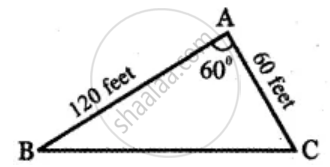Advertisements
Advertisements
Question
A fighter jet has to hit a small target by flying a horizontal distance. When the target is sighted, the pilot measures the angle of depression to be 30°. If after 100 km, the target has an angle of depression of 45°, how far is the target from the fighter jet at that instant?
Solution

Let A be the position of the jet fighter observing the target at an angle of depression 30°.
Also, Let B be the position of the jet 100 k.m away horizontally from A observing the target at an angle of depression 45°.
In ∆TAB,
AB = 100 km
∠TAB = 30°
∠ABT = 180°- 45° = 135°
∠ATB = 180° – (135°+ 300)
= 180° – 165°
= 15°
In ∆ABT, `"BT"/(sin 30^circ) = "AB"/(sin 15^circ)`
BT = `100/(sin 15^circ) xx sin 30^circ`
= `100/(sin(45^circ - 30^circ)) xx 1/2`
= `50/(sin 45^circ cos 30^circ - cos 45^circ sin 30^circ)`
= `50/(1/sqrt(2) xx sqrt(3)/2 - 1/sqrt(2) xx 1/2)`
= `50/((sqrt(3) - 1)/(2sqrt(2))`
= `(50 xx 2sqrt(2))/(sqrt(3) - 1)`
= `(100sqrt(2))/(sqrt(3) - 1) xx (sqrt(3) + 1)/(sqrt(3) + 1)`
= `(100sqrt(2) (sqrt(3) + 1))/(3 - 1)`
= `(100sqrt(2) (sqrt(3) + 1))/2`
= `50sqrt(2) (sqrt(3) + 1)` k.m.
∴ The distance of the target from the position B = `50sqrt(2) (sqrt(3) + 1)` k.m.
APPEARS IN
RELATED QUESTIONS
Determine whether the following measurements produce one triangle, two triangles or no triangle:
∠B = 88°, a = 23, b = 2. Solve if solution exists
If the sides of a ∆ABC are a = 4, b = 6 and c = 8, then show that 4 cos B + 3 cos C = 2
In a ∆ABC, if a = `sqrt(3) - 1`, b = `sqrt(3) + 1` and C = 60° find the other side and other two angles
In a ∆ABC, if a = 12 cm, b = 8 cm and C = 30°, then show that its area is 24 sq.cm
In a ∆ABC, if a = 18 cm, b = 24 cm and c = 30 cm, then show that its area is 216 sq.cm
Two soldiers A and B in two different underground bunkers on a straight road, spot an intruder at the top of a hill. The angle of elevation of the intruder from A and B to the ground level in the eastern direction are 30° and 45° respectively. If A and B stand 5km apart, find the distance of the intruder from B
A researcher wants to determine the width of a pond from east to west, which cannot be done by actual measurement. From a point P, he finds the distance to the eastern-most point of the pond to be 8 km, while the distance to the westernmost point from P to be 6 km. If the angle between the two lines of sight is 60°, find the width of the pond
Two Navy helicopters A and B are flying over the Bay of Bengal at saine altitude from sea level to search a missing boat. Pilots of both the helicopters sight the boat at the same time while they are apart 10 km from each other. If the distance of the boat from A is 6 km and if the line segment AB subtends 60° at the boat, find the distance of the boat from B
A straight tunnel is to be made through a mountain. A surveyor observes the two extremities A and B of the tunnel to be built from a point P in front of the mountain. If AP = 3 km, BP = 5 km, and ∠APB = 120°, then find the length of the tunnel to be built
A farmer wants to purchase a triangular-shaped land with sides 120 feet and 60 feet and the angle included between these two sides is 60°. If the land costs Rs.500 per square feet, find the amount he needed to purchase the land. Also, find the perimeter of the land
A plane is 1 km from one landmark and 2 km from another. From the plane’s point of view, the land between them subtends an angle of 45°. How far apart are the landmarks?
A man starts his morning walk at a point A reaches two points B and C and finally back to A such that ∠A = 60° and ∠B = 45°, AC = 4 km in the ∆ABC. Find the total distance he covered during his morning walk
Suppose that a satellite in space, an earth station, and the centre of earth all lie in the same plane. Let r be the radius of earth and R he the distance from the centre of earth to the satellite. Let d be the distance from the earth station to the satellite. Let 30° be the angle of elevation from the earth station to the satellite, If the line segment connecting the earth station and satellite subtends angle α at the centre of earth then prove that d = `"R"sqrt(1 + ("r"/"R")^2 - 2 ("r"/"R") cos alpha)`
Choose the correct alternative:
In a triangle ABC, sin2A + sin2B + sin2C = 2, then the triangle is
Choose the correct alternative:
The triangle of maximum area with constant perimeter 12m
